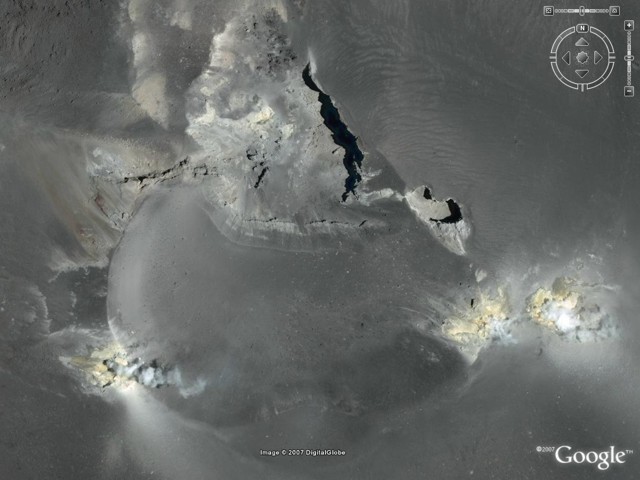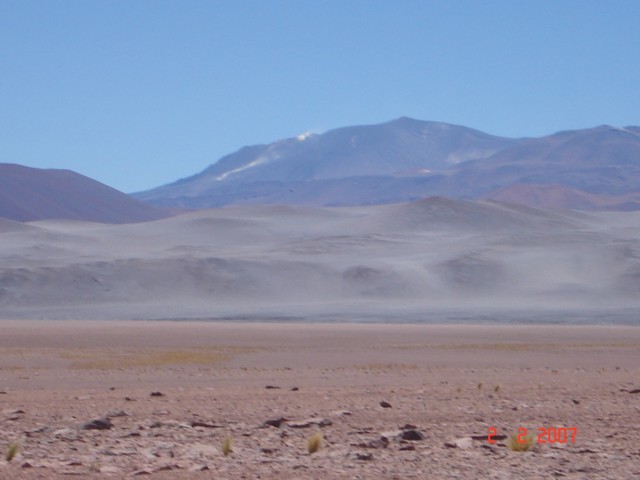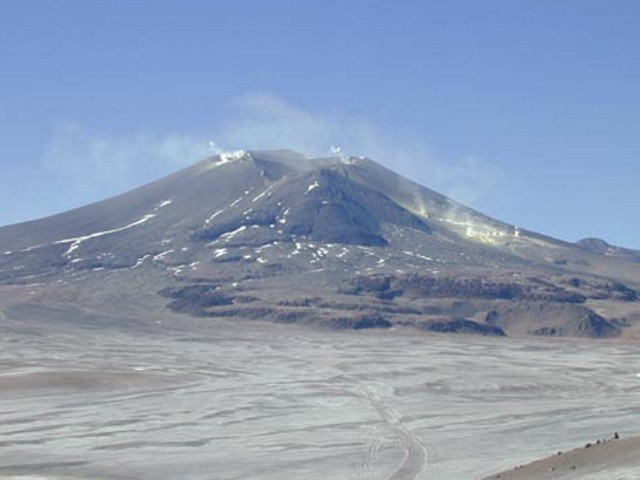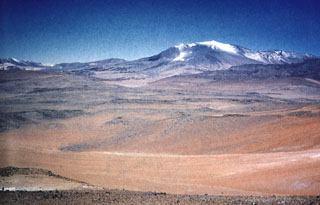Report on Lastarria (Chile-Argentina) — February 2007
Bulletin of the Global Volcanism Network, vol. 32, no. 2 (February 2007)
Managing Editor: Richard Wunderman.
Lastarria (Chile-Argentina) Intense fumarolic emissions typical of activity since at least 1940
Please cite this report as:
Global Volcanism Program, 2007. Report on Lastarria (Chile-Argentina) (Wunderman, R., ed.). Bulletin of the Global Volcanism Network, 32:2. Smithsonian Institution. https://doi.org/10.5479/si.GVP.BGVN200702-355120
Lastarria
Chile-Argentina
25.168°S, 68.507°W; summit elev. 5706 m
All times are local (unless otherwise noted)
The rarely visited Lastarria has not erupted in historical time, but has displayed strong fumarolic activity (figure 1) for at least 67 years. This is the first Bulletin report ever issued on this volcano; it presents new images of the steaming edifice. On 2 February 2007, a group of scientists from the Servicio Nacional de Geología y Minería (SERNAGEOMIN) and the Corporación Nacional Forestal (CONAF) observed the fumarolic activity from a distance. The scientists were on a field trip to count flamingos and other Andean birds at Ramsar sites. The Ramsar Convention on Wetlands (http://www.ramsar.org/), named after a city in Iran, is an intergovernmental treaty that provides the framework for national action and international cooperation for the conservation and wise use of wetlands and their resources. The group noted steam plumes blowing NE at mid-day from ~ 47 km SW. Fumarolic gases were again seen, from ~ 35 km WSW, slowly moving down the W slope of the cone (figure 2). Steam plumes were seen intermittently throughout the afternoon.
 |
Figure 1. Lastarria imaged by satellite on an unknown date. Fumaroles can be seen on the SW and SE crater rims. Crater width (E-W) is ~600 m. Courtesy of Google Earth and DigitalGlobe. |
 |
Figure 2. Photograph showing Lastarria from ~35 km WSW, 2 February 2007. Fumarolic gases can be seen rising above the cone and moving down the W flank. Courtesy of Héctor Cepeda. |
Jose Antonio Naranjo, who has worked at Lastarria since 1983, is very familiar with its spectacular fumarolic activity. He confirmed that the observations of February 2007 reflect Lastarria's normal intense fumarolic emissions. Such activity has continued since at least 1940, when observed by Danko Slozilo. Naranjo noted that in 2007 he saw the same fumarole locations as those he observed in 1983 and in October 2002 (figure 3). The temperatures of these fumaroles were unchanged between 1983 and 2002.
 |
Figure 3. Photograph of the Lastarria cone showing the lava dome overlapping the N crater rim and fumaroles along the rim, October 2002. View is from the N. Courtesy of Jose Antonio Naranjo. |
References. Naranjo, J.A., 1985, Sulphur flows at Lastarria volcano in the North Chilean Andes: Nature, v. 313, no. 6005, p. 778-780.
Naranjo, J.A., 1986, Geology and evolution of the Lastarria volcanic complex, north Chilean Andes: Unpublished M Phil. Thesis, The Open University, England, 157 p.
Naranjo, J.A., and Francis, P., 1987, High velocity debris avalanche at Lastarria volcano in the north Chilean Andes: Bull. Volcanol., v. 49, p. 509-514.
Naranjo, J.A., 1988, Coladas de azufre de los volcanes Lastarria y Bayo en el norte de Chile: reologia, genesis e importancia en geologia planetaria: Revista Geologica de Chile, v. 15, no. 1, p. 3-12.
Naranjo, J.A., 1992, Chemistry and petrological evolution of Lastarria volcanic complex in the north Chilean Andes: Geol. Magazine, v. 129, p. 723-740.
Geological Summary. The NNW-trending edifice of 5706-m-high Lastarria volcano along the Chile-Argentina border contains five nested summit craters. The youngest feature is a lava dome that overlaps the northern crater rim. The large andesitic-dacitic Negriales lava field on the western flanks was erupted from a single SW-flank vent. A large debris-avalanche deposit is found on the SE flank. Recent pyroclastic-flow deposits form an extensive apron below the northern flanks of the volcano. Although no historical eruptions have been recorded, the youthful morphology of deposits suggests activity during historical time. Persistent fumarolic activity occurs at the summit and NW flank, and sulfur flows have been produced by melting of extensive sulfur deposits in the summit region.
Information Contacts: Héctor Cepeda and Margaret Mercado, Servicio Nacional de Geología y Minería (SERNAGEOMIN), Chile; Jorge Carabantes, Cristian Rivera, Eric Díaz, and Juan Soto, Corporación Nacional Forestal (CONAF), Chile; Jose Antonio Naranjo, Volcano Hazards Programme, Servicio Nacional de Geologia y Mineria, Chile.

